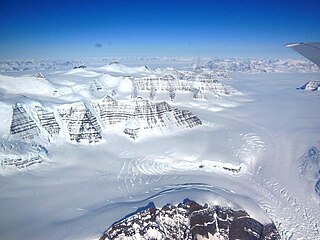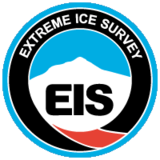
A glacier is a persistent body of dense ice that is constantly moving under its own weight. A glacier forms where the accumulation of snow exceeds its ablation over many years, often centuries. It acquires distinguishing features, such as crevasses and seracs, as it slowly flows and deforms under stresses induced by its weight. As it moves, it abrades rock and debris from its substrate to create landforms such as cirques, moraines, or fjords. Although a glacier may flow into a body of water, it forms only on land and is distinct from the much thinner sea ice and lake ice that form on the surface of bodies of water.

The Arctic is a polar region located at the northernmost part of Earth. The Arctic region consists of the Arctic Ocean, adjacent seas, and parts of Canada, Danish Realm (Greenland), northern Finland, northern Iceland, northern Norway, Russia, northernmost Sweden and the United States (Alaska). Land within the Arctic region has seasonally varying snow and ice cover, with predominantly treeless permafrost under the tundra. Arctic seas contain seasonal sea ice in many places.

The cryosphere is an all-encompassing term for the portions of Earth's surface where water is in solid form, including sea ice, lake ice, river ice, snow cover, glaciers, ice caps, ice sheets, and frozen ground. Thus, there is a wide overlap with the hydrosphere. The cryosphere is an integral part of the global climate system with important linkages and feedbacks generated through its influence on surface energy and moisture fluxes, clouds, precipitation, hydrology, atmospheric and oceanic circulation.

The Byrd Polar and Climate Research Center (BPCRC) is a polar, alpine, and climate research center at The Ohio State University founded in 1960.

In glaciology, an ice cap is a mass of ice that covers less than 50,000 km2 (19,000 sq mi) of land area. Larger ice masses covering more than 50,000 km2 (19,000 sq mi) are termed ice sheets.

Rephotography is the act of repeat photography of the same site, with a time lag between the two images; a diachronic, "then and now" view of a particular area. Some are casual, usually taken from the same view point but without regard to season, lens coverage or framing. Some are very precise and involve a careful study of the original image.

Jakobshavn Glacier, also known as Ilulissat Glacier, is a large outlet glacier in West Greenland. It is located near the Greenlandic town of Ilulissat and ends at the sea in the Ilulissat Icefjord.

The retreat of glaciers since 1850 is well documented and is one of the effects of climate change. The retreat of mountain glaciers, notably in western North America, Asia, the Alps and tropical and subtropical regions of South America, Africa and Indonesia, provide evidence for the rise in global temperatures since the late 19th century. The acceleration of the rate of retreat since 1995 of key outlet glaciers of the Greenland and West Antarctic ice sheets may foreshadow a rise in sea level, which would affect coastal regions. Excluding peripheral glaciers of ice sheets, the total cumulated global glacial losses over the 26-year period from 1993 to 2018 were likely 5500 gigatons, or 210 gigatons per yr.

Grinnell Glacier is in the heart of Glacier National Park in the U.S. state of Montana. The glacier is named for George Bird Grinnell, an early American conservationist and explorer, who was also a strong advocate of ensuring the creation of Glacier National Park. The glacier is in the Lewis Range and rests on the north flank of Mount Gould at an altitude averaging 7,000 feet (2,100 m), in the Many Glacier region of the park.

Blackfoot Glacier is the second largest of the remaining 25 glaciers in Glacier National Park, Montana. Blackfoot Glacier is just to the north of Blackfoot Mountain and near Jackson Glacier. The glacier was most recently measured in 2015 at 370 acres (1.5 km2), yet when first documented in 1850, the glacier also included the now separate Jackson Glacier and together, they covered 1,875 acres (7.59 km2). In 1850, there were an estimated 150 glaciers in the park. Glaciologists have stated that by the year 2030, all the glaciers in the park may disappear. However, under a modest increase in overall carbon dioxide levels, some glaciers will remain until the late 23rd century.

The climate of the Nordic countries is that of a region in Northern Europe that consists of Denmark, Finland, Iceland, Norway and Sweden and their associated territories, which include the Faroe Islands, Greenland and Åland. Stockholm, Sweden has on average the warmest summer of the Nordic capitals, with an average maximum temperature of 23 �/p>

James Balog is an American photographer whose work explores the relationship between humans and nature. He is the founder and director of Earth Vision Institute in Boulder, Colorado.
Mark Dyurgerov was an internationally known glaciologist and Fellow of the Institute of Arctic and Alpine Research (INSTAAR) of the University of Colorado at Boulder. He was born in Moscow, Russia; both of his parents were engineers, and his mother was also a Russian poet.

The North American Arctic is composed of the northern polar regions of Alaska (USA), Northern Canada and Greenland. Major bodies of water include the Arctic Ocean, Hudson Bay, the Gulf of Alaska and North Atlantic Ocean. The North American Arctic lies above the Arctic Circle. It is part of the Arctic, which is the northernmost region on Earth. The western limit is the Seward Peninsula and the Bering Strait. The southern limit is the Arctic Circle latitude of 66° 33’N, which is the approximate limit of the midnight sun and the polar night.

Chasing Ice is a 2012 documentary film about the efforts of nature photographer James Balog and his Extreme Ice Survey (EIS) to publicize the effects of climate change. The film was directed by Jeff Orlowski. It was released in the United States on November 16, 2012.

Jeff Orlowski-Yang is an American filmmaker. He is best known for both directing and producing the Emmy Award-winning documentary Chasing Ice (2012) and Chasing Coral (2017) and for directing The Social Dilemma about the damaging societal impact of social media.

Konrad "Koni" Steffen was a Swiss glaciologist, known for his research into the impact of global warming on the Arctic.
Diane Tuft is an American photographer focusing on nature and landscape photography, documenting the effects of the environment on the Earth's landscape. She is based in New York City.
Jacob Sebastian Haugaard Mernild is a Danish professor in climate change, glaciology and hydrology, who is the pro-vice-chancellor of the University of Southern Denmark. Mernild has been an Intergovernmental Panel on Climate Change (IPCC) author for the United Nations since 2010. Initially a contributing author on the IPCC Fifth Assessment Report, he was lead author on the IPCC Sixth Assessment Report.
Project Pressure is a charity with an ecological and climate focus. Their expressed mission is to create impactful projects that triangulating art, science and activism resulting in impactful actions on environmental issues. The global environmental charity was founded in 2008, with the mission of visualizing the climate crisis. Project Pressure uses art as a touchpoint to inspire action and behavioral change. At the time, Project Pressure focused on work surrounding glacier mass loss.


















